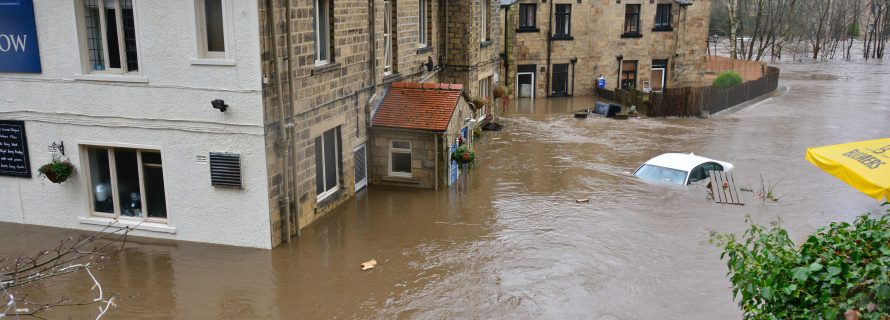Renovating Your Home After a Flood: 5 Helpful Tips

Weather happens, and water from a flood can cause irreversible damage to your homes foundation, structure and your personal property. A flood can happen at any moment, often with little to no warning, and during the spring season, floods are even more common due to heavy rains, rapid snowmelt and dam erosion. While no one plans on seasonal flood damage or renovating their home in response to a weather emergency, sometimes it’s inevitable.
You may have taken preventative measures to protect your property from flood damage, and you may have a contingency plan in place, in case a flood ever hits your home. Whatever you’ve done to prepare, this may be an unexpected opportunity for you to make some changes in your home that you’ve been planning for a while.
After dealing with the initial shock of water damage, and ensuring everyone in your home is safe, your repairs and restoration can begin. Keep these 5 helpful tips in mind when renovating your home after a flood:
1. Call in the professionals
Before you crunch the numbers, make sure you’ve called your insurance company to see what is covered. This will give you a better idea about the out-of-pocket budget you’ll need to set aside for your renovation. If you live in a flood zone, you should be covered by flood insurance, but check with your insurance agent to make sure.
Once you know exactly what you’re working with, find a contractor, a restoration specialist and professional HVAC technicians to assess the damage, air quality and mold, and give you a trusted, realistic opinion. It may be an investment up front, but you’ll be happy to have professionals on the scene when you’re ready to start renovating.
2. Prioritize structural elements
If you’re working on a budget, make sure structural elements like walls, floors (and subflooring) and the roof are at the top of the list. While it’s tempting to prioritize design elements like cabinetry and light fixtures, structural elements are more exposed to the flood water in most cases, and they need to be strong in order to ensure your house is safe and structurally stable.
Wood studs and drywall aren’t glamorous, but they absorb water and could cause further damage to your house if they are not completely ripped out and replaced. If you want to make the most out of your unplanned renovation, consider taking this opportunity to open up that kitchen wall to create an open concept floor plan, or adding that hardwood floor you’ve had your eye on for years.
3. Open up your walls
Even if water hasn’t reached every corner, it’s important to open up your walls to allow the wall cavities to dry properly. Most contractors will remove drywall up to one foot above the water line, as well as any existing insulation.
If you’re hoping to salvage any insulation, remember, it won’t ever dry fully, and if left unreplaced, it could cause mold to grow and spread throughout your house. Installing new insulation could even save you money on your utility bill by keeping heat and cool air inside the house.
4. Do small projects to keep things moving
Going through an unplanned renovation can be stressful, costly and overwhelming. It’s important that you have space in your home that makes you feel rested and restored, which can be challenging in a construction zone. However, there are plenty of ways to make your home comfortable in the meantime.
If your budget or timeline doesn’t allow you to complete all your renovations at once, find easy solutions in smaller spaces that can help you feel more at home right away, even if you have bigger plans for that space down the road. It’s amazing what a can of paint or a temporary seating area can do.
5. Consider preventative options
Talk to your contractor about what kind of products and options you have to prevent damage in the future. There are a number of smart home technologies available on the market that can help you keep an eye on your air quality, monitor water leaks, and detect fire or smoke, even when you aren’t in your home.
Manufacturers have also been able to innovate and improve their products over the years, such as roofing materials, windows and doors, gutters and downspouts, and other drainage and irrigation systems. Talk to your contractor about what types of upgrades you should make to prevent another flood in your home.
Water damage can be devastating to a house, but that doesn’t mean you can’t restore your home and make it into something you’ve always wanted. Take advantage of your circumstances and use this as an opportunity to rebuild, renovate and design your dream home. Between your vision and the help of professional restorers, you’ll be back in your home in no time.
About The Author: David Cruz is a freelance writer. He covers topics ranging from home improvement to real estate trends across the country. When he’s not writing, he’s watching basketball and playing with his dog.
Photo by Chris Gallagher on Unsplash
- Additions and New Construction
- All Exteriors
- Alterations
- Basements
- Bathrooms
- Customer Service
- Customer Stories
- Decks
- Design & Planning Show
- DIY
- Doors
- Educational Resources
- Extreme Makeover Home Edition
- Fashion Show
- General Remodeling
- Green Living
- Handyman Home Services
- Home Decor
- Home Entertainment
- Home Improvement
- Home Improvements
- How to Tips
- In The Community
- Kitchens
- Off-the-Wall Remodeling Stories
- Remodeling
- Resources
- Roofing
- Siding
- Social Media
- Sunrooms
- Tips & Tricks
- Trends
- Windows

